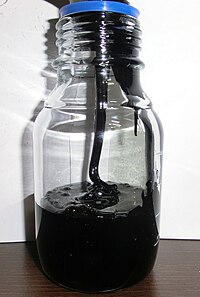
Photo from wikipedia
Abstract To study CO2 capture potential, three types of transition-temperature mixtures (TTMs) were prepared by mixing ethyltriphenylphosphonium bromide (MTPPB) as a hydrogen bond acceptor (HBA) and n-methyl diethanolamine (MDEA) as… Click to show full abstract
Abstract To study CO2 capture potential, three types of transition-temperature mixtures (TTMs) were prepared by mixing ethyltriphenylphosphonium bromide (MTPPB) as a hydrogen bond acceptor (HBA) and n-methyl diethanolamine (MDEA) as a hydrogen bond donor (HBD) in different molar ratios (1:7, 1:10 and 1:16). Fourier transform infrared spectroscopy (FT-IR) results showed that TTMs have almost similar spectra to their HBD (MDEA) with different levels of transmittance and exhibit similar behavior. From the experimental results, it was found that the thermal stability, viscosity and surface tension of TTMs decreased as the concentration of MDEA in the mixture increased. According to response surface methodology (RSM) models and analysis of variance (ANOVA), temperature and molar ratio had a great effect on the viscosity and surface tension of TTMs. Finally, it was found that CO2 solubility in TTMs (at 303.15 K at pressure up to 1.35 MPa) was enhanced as the MDEA quantity increased in the mixture up to 1:10 mol ratio. However, by increasing MDEA concentration to 16:1 mol ratio, there was a decreasing trend in the CO2 solubility data. Also, all TTMs, particularly TTM containing 10:1 mol MDEA (MTPPB-MDEA 1:10) exhibited an equilibrium loading capacity approaching 1 mol CO2 per mole solvent at high pressure, revealing their high potential for CO2 capture. A comparison showed that the CO2 solubility in the studied solvents was higher than that of existing deep eutectic solvents (DESs) and other TTMs as well as several ionic liquids (ILs) to date. To the best of our knowledge, this is the first study to report the CO2 solubility in phosphonium-base TTMs containing MDEA.
Journal Title: Journal of Molecular Liquids
Year Published: 2020
Link to full text (if available)
Share on Social Media: Sign Up to like & get
recommendations!